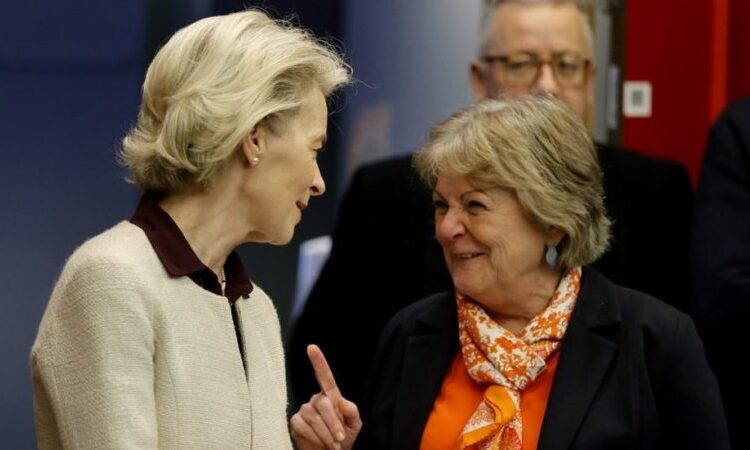
New EU priorities, such as defence, should not come at the cost of helping poorer EU regions, European Commissioner for Cohesion Elisa Ferreira told Euractiv on Monday (3 June) in Berlin.
Means for Regional Development and Cohesion account for €290 billion in the EU’s current seven-year long-term budget (MFF) for 2021-2027. After the €350 billion for agriculture and maritime policy, it is the second-largest pot of money.
“[Having an] Internal Market requires […] that you have an instrument that helps the different regions to speed up, particularly the weakest ones and the more challenged ones,” Ferreira told Euractiv after she met with lawmakers from the German Bundestag’s committees for EU and economic.
“I think all of us in Europe have to be intelligent enough to accommodate new priorities, not at the cost of something absolutely essential,” she said.
Green MP Anton Hofreiter, head of the Bundestag’s EU Affairs Committee, similarly warned that “the concern is there” that new priorities in the EU budget could reduce cohesion funds.
Theoretically, the European Commission set out a measure in 2023 that would prevent any EU policy from conflicting with cohesion objectives under the “no harm to cohesion” principle.
Hofreiter said he favoured a new EU-level debt-financed €500 billion fund that could finance defence and related investments “to avoid getting into this competition” between defence and cohesion spending.
Meanwhile, MP Gunther Krichbaum, lead lawmaker for EU affairs of the conservative opposition party CDU (EPP), told Euractiv ahead of the talks that “there must be a new prioritisation in the next EU financial framework, in which the areas of security and defence are given greater and more comprehensive consideration”.
This was due to the “immense geopolitical challenges of our time, such as the Russian war of aggression with all its consequences or the Middle East conflict,” Krichbaum added, “In this context, the existing cohesion funds must also be evaluated.”
The European Commission, EU member states and the Parliament have been looking at ways to find more cash for the defence industry as they look to boost the bloc’s military-industrial complex, which led the European Investment Bank (EIB) to change its lending policy and the earmarking of part of the windfall profits from Russian immobilised assets to Ukraine’s industry.
A proposed emergency programme recently included the possibility for regions to use cohesion funds to bolster ammunition production as an incentive for job creation but did not make it to the final text.
Some larger countries refused to pay for another country’s defence industry, while some poorer countries refused to reassign funds to a new purpose.
The EU executive tabled the option again when presenting its long-term European defence industry programme (EDIP), which was allocated the modest financial envelope of €1.5 billion and is currently being discussed.
EU leaders have asked the EU executive to investigate all options, including joint borrowing from financial markets (Eurobonds), which has been met with resistance. The Commission is set to present a draft text in the coming weeks.
In his recent report, former Italian prime minister Enrico Letta suggested EU countries could also use the European Stability Mechanism (ESM), also known as the EU’s ‘bailout’ fund for countries on the verge of sovereign debt or bank crisis.
The next long-term budget will be different.
“In view of the changed geopolitical situation, the structure of the next EU budget will differ significantly from previous budgets,” MP Christian Petry, a lawmaker of leading government party SPD (S&D), told Euractiv.
However, “it is not yet possible to say who will have to make cuts and where,” he said, adding that he expected that “cohesion policy funds should be high enough to continue the previous funding areas.”
Germany is the biggest net contributor to the EU budget, and with money in the national budget being tight, a top-up of national contributions could prove unpopular.
Looking at cohesion policy as a share of GDP, Germany ranks as the EU’s fourth net contributor, after France, Finland, and Denmark, according to an analysis by the business-funded German Economic Institute (IW).
However, “the [EU] budget is 1% of overall wealth,” Ferreira underlined, with cohesion funding accounting for one-third of the bloc’s budget.
“And it does amazing things because it has created opportunities, and the benefit is not just for the more evident recipient countries,” she said, adding that market integration – benefitting German producers – would go “hand in hand with cohesion”.
Enlargement to shake up distribution
The next MFF, from 2028 to 2034, could see a shake-up due to the EU’s new focus on joint defence projects and new countries joining the bloc. This would see cohesion funding shifting to the East, while the current beneficiaries could lose their support.
This has sparked concerns, particularly in comparably richer beneficiary regions—such as the German Saarland region—which argue that they also need continuous cohesion funds to catch up with even wealthier regions in the country. They say that new needs would also arise due to the ongoing transition towards climate neutrality, which will particularly hit some industry-heavy areas.
“An EU with more than 30 members will massively change cohesion policy,” Thomas Hacker, lead MP on EU affairs for liberal FDP (Renew), told Euractiv. “Today’s net recipients will become net contributors.”
“The focus of cohesion policy would shift towards the Balkans as well as Ukraine and Moldova,” he added. However, Hacker spoke against topping up the cohesion budget, arguing that “there is enough money lying around unused in Brussels.”
“Unclaimed funds should be reallocated instead of demanding more and more revenue for the EU,” Hacker said.
[Additional reporting by Aurélie Pugnet]
[Edited by Anna Brunetti/Alexandra Brzozowski/Alice Taylor]







